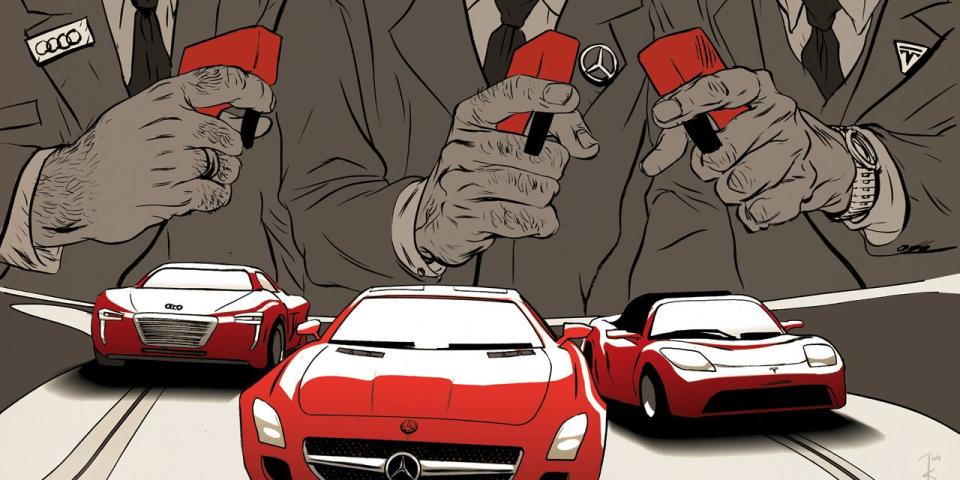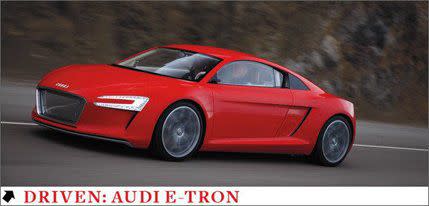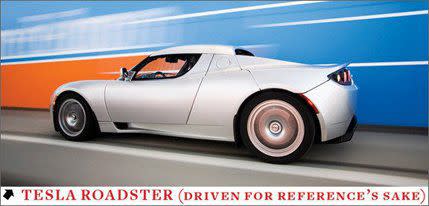Audi E-Tron, Tesla Roadster, M-B SLS AMG eDrive Charge to Production


In two years, both Mercedes-Benz and Audi will put electric supercars into production. Shown as concepts at last year’s Frankfurt show, the Audi e-tron and the Mercedes SLS e-drive each slot an electric powertrain into an existing platform. Both promise green cred, but the big question is this: Will either be any good as a supercar?
To be credible as such, both concepts are outfitted with powerful electric motors. Audi’s e-tron makes 313 horsepower and 502 pound-feet of torque from its four electric motors, which also provide four-wheel drive (one motor powers each wheel). By contrast, the V-8 in the Audi R8 supercar makes 420 horsepower, 525 horses with the V-10. Not surprisingly, the electric Audi can’t match the acceleration of its gas-fed counterparts. Audi claims a zero-to-62-mph time of 4.8 seconds and a top speed of 124 mph for the electric e-tron. Not quite a supercaresque top speed.
Over at Mercedes, the SLS eDrive also has four electric motors that provide all-wheel drive, but the Benz trumps the Audi in power output. The SLS’s electric motors add up to 526 horsepower and 649 pound-feet of torque. The goal of the company’s performance division, AMG, was for the electric SLS to match the acceleration of the gas-powered 563 horsepower version. If the SLS eDrive actually hits its claimed zero-to-60 time of less than four seconds, it will be a close match for its V-8 sibling. However, the top speed, although said to be in excess of 125 mph, is still a far cry from the near 200 mph of the gas SLS.
Owners wishing to tap into this performance—why else would you spend all that money on a supercar?—will find that the batteries just don’t have the energy density to cope with the power demands. Audi claims the 53-kilowatt-hour battery pack powering the e-tron is good for a 154-mile drive. However, the car uses only 42.4 kWh of its total output for propulsion, in order to lengthen the life expectancy of the battery. That total usable capacity of the battery pack, which weighs more than 1000 pounds, contains the same amount of energy as about 1.2 gallons, or eight pounds, of gas. In the Benz, three 16-kWh lithium-ion battery packs add up to 48 kWh, the energy equivalent of about 1.3 gallons of gas. So Mercedes doesn’t expect its electric SLS to travel more than 100 miles on a charge even when driven slowly.
Recharging is problematic as well as time-consuming. Using a high-voltage charger, depleted batteries would take about three hours to reenergize; a 220-volt home-charger would mean 6 to 10 hours, and a household 120-volt plug would require more than 30 hours.
In addition to being prohibitively expensive—every kWh of battery storage currently costs roughly $1000—the batteries are also very heavy. As noted, the Audi’s pack weighs about 1040 pounds, and the SLS’s batteries likely weigh roughly the same. Fortunately, both supercars have lightweight aluminum structures to offset that bulk, but curb weights are still expected to top 4000 pounds, a gain of about 400 pounds over the current gasoline versions. And like the batteries, using aluminum in cars isn’t exactly cheap technology; both cars are likely to cost more than $200,000.
Lengthy charging times, restricted range, expensive, and heavy—it all adds up to a not very appealing or practical combination. We asked Dr. Thomas Weber, Mercedes-Benz board member and chief of car development, about the SLS eDrive’s prospective customers. Weber believes the car will be purchased as a green status symbol and probably won’t be cross-shopped by anyone interested in the gas SLS. We take that to mean the eDrive is definitely not for car enthusiasts.
These two supercars make sense only as learning tools. Neither automaker believes these vehicles will be popular, so they’ll be built in tiny numbers. Both brands are using the cars as a high-profile and public-relations-friendly proving ground for battery and electric-drive technology. Furthermore, these projects will help engineers develop the know-how to build a mass-market electric car. Lessons learned in battery technology, battery cooling, and control systems will make their way into mass-produced cars such as Mercedes’ next-gen A-class minicar, the next Smart Fortwo, and the upcoming Audi A2: All will have electric variants within the next five years. Current battery technology is advanced enough to power these cars, provided they are used as nothing more than errand runners.
What this push toward electrification shows is that the German car industry hopes to lead in electric technology. After falling behind the Japanese with hybrids, the Germans are being careful to stay ahead of the electric-car curve.

From behind the wheel, the e-tron concept feels quite agile despite being a one-of-a-kind, hand-built car. Acceleration from zero to 62 mph feels quicker than the claimed 4.8 seconds, thanks to the immediately available 502 pound-feet of torque and the traction from the all-wheel-drive system. Out of respect for the likely multimillion-dollar show car, we didn’t explore the 124-mph top speed.
Despite its electric propulsion system, the e-tron manages to retain the amazing straight-line stability, the precise steering, and the tremendous braking performance of the gas R8. But it’s still slower than a V-8 R8, and the nearly silent whir of the electric motor is no match for the song of an engine.
High-speed cornering is alarmingly spooky, though the e-tron is not a finished car. Also, the 4000-plus-pound curb weight conspires against directional changes. Audi says it plans to get the production version closer to 3500 pounds. Even if the target weight is achieved, it will still be slower than either gas R8. Driven hard, its range may be under 60 miles. Not much fun for the $200,000 price. And there’s also the wait to recharge the battery pack.

We’ve driven the Tesla Roadster before [“Circuit Soleil,” May 2009], but that test was limited to the roads of Southern California. This time we drove the American electric on the autobahn between Munich, Germany, and Salzburg, Austria.
With Munich behind us and about 90 miles ahead of us, the traffic was moving fluidly between speeds of 80 and 105 mph, and the single-gear Tesla had no problem keeping up. The Tesla’s regenerative-braking system, which recharges the batteries, is aggressive enough that lifting off the throttle feels like light braking—in fact, the Tesla shows brake lights whenever the driver lifts off the throttle.
On the autobahn, most drivers were oblivious to the Tesla, with the exception of a particular Porsche 911 driver. From time to time, he would speed up in an attempt to leave us behind. But the Tesla accelerated in an eerily quiet and effortless manner all the way to 124 mph. After several miles, the 911 driver let us take the lead, and that is when we noticed the Tesla’s range indicator had just 68 miles remaining. It had been about 45 minutes since leaving Munich with a fully charged 53-kWh battery pack. So we were faced with exiting the autobahn and heading back to Munich or finding a facility to recharge the Tesla, not to mention finding something to occupy ourselves for the eight to 10 hours it would take. Not much of a choice, we thought, as we turned the electric toy around.
You Might Also Like

 Yahoo Autos
Yahoo Autos 